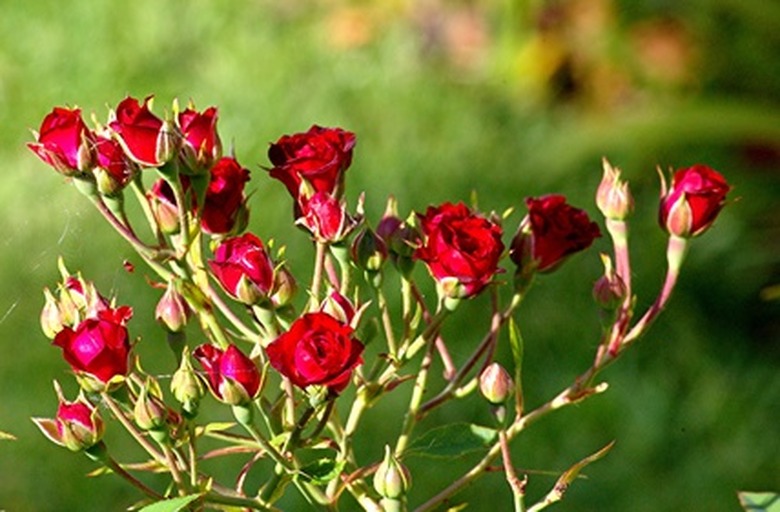Miniature Rose Plant Diseases
Miniature roses are just that–miniature versions of the common shrub rose. As such, they are subject to the same diseases that plague their larger counterparts. These tiny flowers are often grown in pots, but they can also be planted directly into the ground and make great border plants. Miniature roses are extremely winter hardy, according to horticulturists at the University of Illinois, but they are also more susceptible to rose diseases than large roses.
Blackspot
Blackspot is the most serious of rose diseases, according to A.R. Chase, founder of the Chase Horticultural Research Center and a plant pathology expert formerly with the University of Florida. The fungal disease can quickly defoliate a miniature rose bush in just one growing season. Blackspot gets its name from the first symptom of the disease; the appearance of black spots on the leaves of the rose bush. The leaves eventually turn yellow and fall off. Cankers (sunken, cracked areas of wood) appear on the branches, and the plant becomes very weak.
- Miniature roses are just that–miniature versions of the common shrub rose.
- Miniature roses are extremely winter hardy, according to horticulturists at the University of Illinois, but they are also more susceptible to rose diseases than large roses.
The fungus is spread through splashing water. When water sits on the leaves for a long period of time, the fungus can infect the plant. This can happen during warm, wet springs, or even from watering from above rather than watering at the ground level of the plant.
Prune away any infected canes, and make sure all of your miniature rose bushes have room for air around them. Blackspot can also overwinter in the ground on pruned branches or infected leaves; therefore remove any debris immediately. Finally, treat your miniature rose bushes with a preventative fungicide in the spring, before new buds appear.
Botrytis Blight
Botrytis blight, like blackspot, is caused by a fungus. Instead of black spots, an infected rose bush will look like it is covered with a thin layer of gray fuzz. This disease tends to attack miniature roses that are already weak or dying for another reason. For this reason, it is important to remove wilted flowers from the bush as soon as possible. Warm, wet weather also encourages this disease. Botrytis blight can be prevented with a spring application of fungicide.
- The fungus is spread through splashing water.
- For this reason, it is important to remove wilted flowers from the bush as soon as possible.
Mosaic
Mosaic is a disease that attacks many plants. When it attacks roses, it is appropriately called rose mosaic. This virus is spread by biting or chewing insects, such as aphids.
Miniature roses affected with mosaic might show stunted growth; wavy, yellow lines on the foliage or just go into a general decline. Mosaic cannot be cured. Once a plant is infected, it should be removed and destroyed so that the virus does not spread to other, nearby plants. The best way to prevent it is to control the insect pests that bother your miniature roses.
- Mosaic is a disease that attacks many plants.
- Once a plant is infected, it should be removed and destroyed so that the virus does not spread to other, nearby plants.
Crown Gall
Crown Gall is not caused by a virus or fungi. It is a bacterial disease that can live for a decade or more in the soil before it attacks a plant. This disease causes galls to form on miniature roses. They usually grow near the soil, on the canes. Galls are swollen, dark masses of stem tissue. As they grow, they can girdle the stem, cutting off the supply of nutrients to the rose, causing it to decline and eventually die.
Crown gall cannot be treated. Once infected, the plant should be immediately removed and destroyed. In addition, the soil should not be used for any type of plant for at least five years, as crown gall can affect other plants as well. Buy hardy miniature rose species that do not have suspicious swelling on the canes to try to prevent the disease.
- Crown Gall is not caused by a virus or fungi.
- Buy hardy miniature rose species that do not have suspicious swelling on the canes to try to prevent the disease.
